

Monterey Bay has more microplastics than Great Pacific Garbage Patch, researchers say - SFGate. Giant kelp grows underwater in the Monterey Bay.
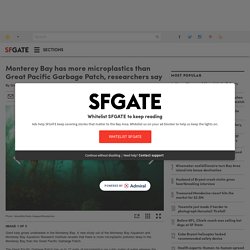
Microplastics found in 90 percent of table salt: potential health impacts? In partnership with the National Geographic Society.
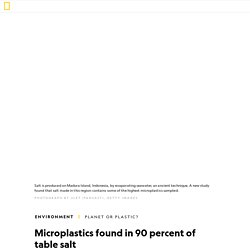
From Fish to Humans, A Microplastic Invasion May Be Taking a Toll. This is the second of a three-part series that examines our growing understanding of the scope and impacts of microplastics pollution.
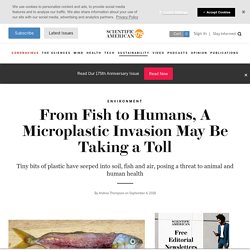
Mark Browne had a suspicion. He hoped the samples of dried blood taken from a blue mussel and placed under a special microscope would tell him if he was correct. As a fuzzy, three-dimensional image of the mussel’s blood cells appeared, there they were, right in the middle—tiny specks of plastic. Whereas photos of sea turtles eating plastic bags have become the poster child of the environmental harm wrought by humanity’s plastic waste, research like Browne’s illustrates the scope of the problem is far larger than the trash we can see. Microplastics in our fresh water?
Microplastics in water supplies have been identified by the United Nations as a threat similar to climate change – and now research is under way to see if they are present in how New Zealand's fresh water.

This major new study, to investigate the extent of water contamination by microplastics in New Zealand is being led by Institute of Environmental Science and Research (ESR) scientist Dr Olga Pantos and environmental consultant Dr Grant Northcott. More than $12.5 million in government funding has been allocated for research on the impact of microplastics and the threat they pose to New Zealand's ecosystems, animals and people. Recent overseas studies have shown microplastic particles in drinking water and food, and the United Nations Environment Programme recently likened the issue to climate change, due to its global scale and the magnitude of potential risks it poses to ecosystems and human health. How dangerous is microplastic?
After alarming reports of microplastic pollution in oceans and beaches, the global scientific community intensified its focus into this area.
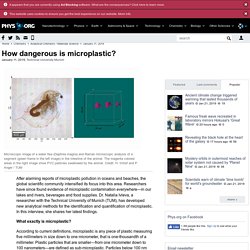
Researchers have since found evidence of microplastic contamination everywhere—in our lakes and rivers, beverages and food supplies. Dr. Natalia Ivleva, a researcher with the Technical University of Munich (TUM), has developed new analytical methods for the identification and quantification of microplastic. In this interview, she shares her latest findings. What exactly is microplastic? Scientists say microplastics are all over farmlands, but we're ignoring the problem - ABC Rural - ABC News. Focus on the impacts of microplastics has almost entirely been on the world's oceans, but researchers say an even bigger problem could be hiding under our feet. plastics key points Key points: Between 107,000-730,000 tonnes of microplastic are added to European and North American farmlands each yearIn 2017, Australia produced 327,000 tonnes of dry biosolids containing microplastics and 75 per cent of it was used in agricultureResearchers say there is a lack of public awareness and scientific understanding of the issue Microplastics are particles smaller than five millimetres.
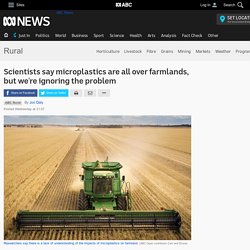
About 800,000 to 2.5 million tonnes of these tiny pieces of plastic are estimated to end up in oceans each year, according to the International Union for Conservation of Nature and Natural Resources. However, not much is known about the damage these particles cause to landscapes as they make their way to the sea. The plastics find their way into agricultural soils through recycled wastewater and rubbish. Microplastics have entered our bodies via food chain: Scientist - National - The Jakarta Post. Microplastics Have Been Found in People's Poop—What Does It Mean? Everywhere scientists have looked for them they have found tiny bits of degraded plastic—including, now, in human poop.
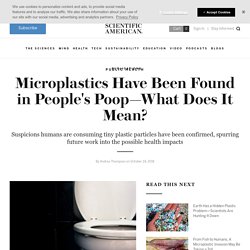
New research provides evidence of something scientists have suspected since microplastics were first detected in seafood, salt and bottled water: People are eating plastic particles, and excreting at least some of them. Although the study is a small one, geared toward showing microplastics can be detected in excrement and are actually found there, it tees up future work to look for broader patterns of human microplastic exposure and the potential associated health impacts. Microplastics human poop. The Great Pacific Garbage Patch: Cleaning up the plastic in the ocean - 60 Minutes. Editor's Note: Since 60 Minutes brought you our story on The Plastic Plague, highlighting the work of a young Dutchman named Boyan Slat and his ambitious plan to clean up the world's ocean plastic, he's encountered a series of major setbacks.

In November, Slat revealed that the device he'd deployed in the Great Pacific Garbage Patch wasn't collecting plastic at all. Then, just before New Year's Eve, there was more bad news: a 60-foot chunk of his 2,000-foot ocean boom broke off, and began floating away. Engineers managed to salvage the runaway piece, and have begun towing the entire device back to shore where they will try to solve the problems. Microplastics Found in Human Poop for the First Time. Tiny pieces of plastic measuring less than five millimeters in length—or roughly the size of a sesame seed—have become a nearly ubiquitous presence in our world.
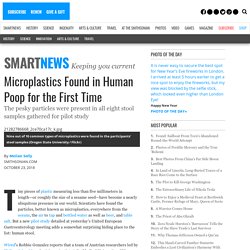
Scientists have found the particles, better known as microplastics, everywhere from the oceans, the air to tap and bottled water as well as beer, and table salt. But a new pilot study detailed at yesterday’s United European Gastroenterology meeting adds a somewhat surprising hiding place to the list: human stool. Wired’s Robbie Gonzalez reports that a team of Austrian researchers led by Philipp Schwabl, a physician-scientist at the Medical University of Vienna, asked eight participants from eight different countries—Austria, Italy, Finland, Japan, the Netherlands, Poland, Russia and the United Kingdom—to track their food consumption over the course of one week and provide a stool sample at the end of the testing window. “We didn’t study harm,” Schwabl concludes. Brain damage in fish from plastic nanoparticles in water. Calculations have shown that 10 per cent of all plastic produced around the world ultimately ends up in the oceans.
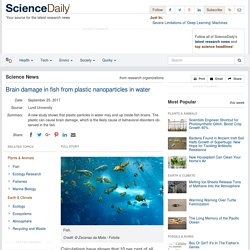
As a result, a large majority of global marine debris is in fact plastic waste. Human production of plastics is a well-known environmental concern, but few studies have studied the effects of tiny plastic particles, known as nanoplastic particles. "Our study is the first to show that nanosized plastic particles can accumulate in fish brains," says Tommy Cedervall, a chemistry researcher at Lund University. The Lund University researchers studied how nanoplastics may be transported through different organisms in the aquatic ecosystem, i.e. via algae and animal plankton to larger fish. Ninety-nine percent of the ocean's plastic is missing. Millions of tons. That’s how much plastic should be floating in the world’s oceans, given our ubiquitous use of the stuff. But a new study finds that 99% of this plastic is missing. One disturbing possibility: Fish are eating it.
If that’s the case, “there is potential for this plastic to enter the global ocean food web,” says Carlos Duarte, an oceanographer at the University of Western Australia, Crawley. Albatross. YouTube. BPA-Free Plastic Containers May Be Just as Hazardous. In 2012 the U.S. Food and Drug Administration banned the sale of baby bottles that contain bisphenol A (BPA), a compound frequently found in plastics. The ban came after manufacturers’ responded to consumer concerns of BPA's safety after several studies found the chemical mimics estrogen and could harm brain and reproductive development in fetuses, infants and children.* Since then store shelves have been lined with BPA-free bottles for babies and adults alike. Yet, recent research reveals that a common BPA replacement, bisphenol S (BPS), may be just as harmful.
BPA is the starting material for making polycarbonate plastics. Any leftover BPA that is not consumed in the reaction used to make a plastic container can leach into its contents. Yet BPS is getting out. 160421171351. San Jose’s foam food container ban hitting nearly all restaurants now – The Mercury News. SAN JOSE — More than a year after San Jose became the largest city in the state — and perhaps the nation — to dump foam food containers, the ban finally goes into effect Thursday for most smaller restaurants. About 500 businesses, from mom-and-pop restaurants and coffee shops to bars and food trucks, will have to switch out cups, plates, clamshell to-go containers and other “expanded polystyrene” materials, typically known as Styrofoam.
The foam, which does not degrade and has become a huge source of litter, was already banned at chain restaurants in San Jose a year prior. Despite initial fears over the change driving up costs to businesses when the City Council approved the ban in August 2013, the groaning has generally subsided since. Just about every other city in Santa Clara County has adopted similar bans, as have hundreds of big and small cities across the nation, creating a market for non-polystyrene materials that has made them just as cheap as Styrofoam, city officials say. Milpitas: City foam container ban may cover delis, grocery stores. Not satisfied with simply banning the use of foam food containers in restaurants here, Milpitas City Council is looking to expand a pending ban to also cover any businesses where food is served or shared in foam, including small delis and grocery stores. Milpitas restaurants will need to find alternative vehicles for serving food other than expanded polystyrene foam foodware before July 1, 2018, when a citywide ban takes effect.
The council, which approved the ban on May 16, also approved a city policy that would prevent the use of foam food containers at all city facilities, city-managed concessions, city-sponsored events and for any food vendors doing business with the city. The Laws on Plastic Bags: To Ban or Tax? When it comes to single-use plastic bags, the disposal issue is becoming less about whether they are recycled and more about what some cities are doing to reduce their existence in the first place. If you live in a city near a body of water, it’s likely that there has been legislation proposed or passed to either ban single-use plastic bags or charge a fee for each bag you require at the grocery store. This is because plastic bags are frequently cited as the largest component of marine debris, due to their light weight and frequent use at beaches.
Ww2.kqed. Nation's first statewide plastic-bag ban now in effect across California - The San Diego Union-Tribune. Many grocery-store shoppers have been surprised at the checkout stand in recent days. 'Great Pacific garbage patch' far bigger than imagined, aerial survey shows. When seabirds smell plastic in the ocean, they think it's time to eat. By 2050, there will be more plastic than fish in the world’s oceans, study says.
A September 2008 photo released by the Ocean Conservancy on March 10, 2009, shows a trash-covered beach in Manilla, Philippines. Welcome to Ground Zero of the Ocean Plastic Pollution Crisis. My alarm goes off at 4am. How did that get there? Plastic chunks on Arctic ice show how far pollution has spread. Plastics News. Plastic Garbage Patch Bigger Than Mexico Found in Pacific. Water, water, everywhere—and most of it is filled with plastic. New material converts CO2 into clean fuel with unprecedented efficiency. A new material made from microscopic layers of cobalt can convert carbon dioxide gas into formate - a fuel that can be burned with no toxic byproducts and used as a clean energy source. Developed by a team of researchers in China, the material could be one way to deal with the 36 gigatonnes of CO2 we release into the atmosphere each year due to fossil fuel use.
Scientists have been struggling for decades to come up with an energy-efficient way to transform CO2 into something useful, and early testing points to this new material as being one of the most promising options we’ve seen so far. Johnson & Johnson ditch plastic cotton buds to save oceans If you eat seafood, you are eating thousands of pieces of plastic. Seafood fans are ingesting up to 11,000 tiny pieces of plastic a year with unknown health effects, a new study reveals. If This Plastic Bag Ends Up In The Ocean, Don't Worry. Meeting with automakers in January, Donald Trump vowed to make Detroit's life easier. He said regulations on the auto industry are "out of control" and that his administration would create an "extremely hospitable" environment for making and selling cars in this country.
From the Mariana Trench to the Arctic: plastic pollution is ocean enemy number one. Seafood eaters ingest up to 11,000 tiny pieces of plastic every year, study shows New report looks at investment strategies for plastic-free seas. Great Pacific Garbage Patch - National Geographic Society. Plankton eating plastic caught on camera for the first time.
BPA alternative disrupts normal brain-cell growth, is tied to hyperactivity, study says. Recycling machines. Documentary: Plastic pollution in our oceans. Plastic Seas, documentary by Jeneene Chatowsky - Algalita. This Video Shows How Garbage Patches Form in the Ocean. Adrift: tracking the global ocean circulation. Cleaning the Air with Plastic [Excerpt] Microplastics found in supermarket fish, shellfish. 6 Reasons That Floating Ocean Plastic Cleanup Gizmo is a Horrible Idea.
A German city just became the first in the world to ban single-use coffee pods. The First American City to Ban Plastic Water Bottles — Plastic Pollution Coalition. By 2050, there'll be more plastic than fish in our oceans. Zooplankton Are Eating Plastic, And That's Bad News For Ocean Life. Scientists find worms can safely eat the plastic in our garbage. LA is dumping millions of small plastic balls into its reservoir to tackle the drought.
Holy crap. Watch this guy turn plastic back into oil. The Ocean Cleanup, Part 2: Technical review of the feasibility study. Inside the lonely fight against the biggest environmental problem you've never heard of. Global Plastic Production Rises, Recycling Lags. Plastic Ocean Waste Levels Going Up, Study Says. Marine Debris Deadly to Whales, Dolphins. Pantry Pests Harbor Plastic-Chomping Bacteria. Using Bacteria to Break Down Plastic Waste. Look who’s eating your plastic now: A whole unprecedented ecosystem. 'Plastic-Eating' Microbes Help Marine Debris Sink. Foodweb Activity. Report: Ocean Is Filled With Trillions of Plastic Pieces. Ninety-nine percent of the ocean's plastic is missing. This new plastic breaks down in just 3 hours. A Mini Farm That Produces Food From Plastic-Eating Mushrooms.